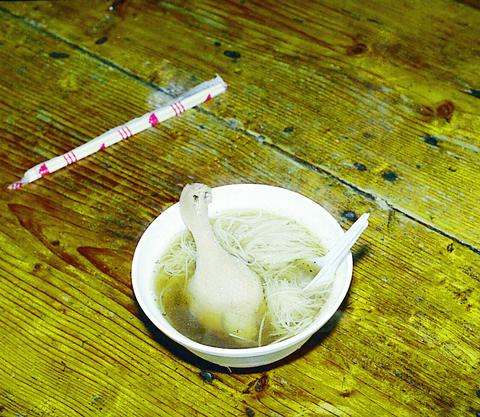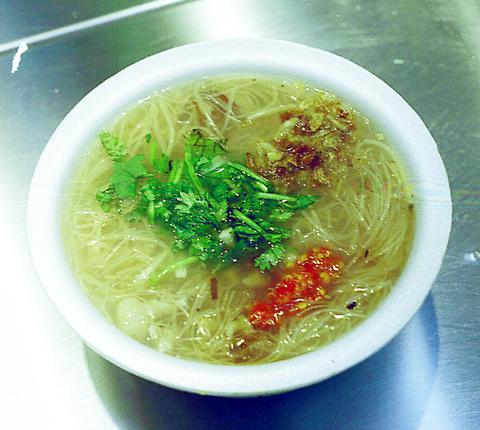Ah Hsin Noodles
(阿鑫麵線)

PHOTO: IAN BARTHOLOMEW
8, Lane 39, Shita Rd.,(北市師大路39巷8號), tel:(02)2363-3695. Open:3pm-10pm; Average meal:NT$50; No English menu; no credit cards.
Rediscovering fundamentals is what some of the best cooking is about, and for Chen Shao-hsin (陳紹鑫), who has traveled around Taiwan tasting hundreds of versions of a single Taiwanese noodle dish, he has settled on a recipe and has no intention of changing it.

PHOTO: IAN BARTHOLOMEW
Mian hsian (麵線), a thread-thin noodle made from wheat floor, is served in a wide variety of dishes, one of the most popular being with pig's intestines. It is a dish available in thousands of roadside stalls, and is generally remarkable for its strong flavor, usually the product of large quantities of MSG.

PHOTO: IAN BARTHOLOMEW
Ah Hsin, who has manufactured electrical toys and raised dogs commercially has become a fixture of the Shita night market over the last 11 years. Located outside a Japanese knick-knack store owned by his mother, Ah Chung's polished stainless steel stand looks more hygienic than the usual street-side stall. He is dressed in a dapper chef's jacket and cap, which looks attractively incongruous.
Only one dish is served at Ah Hsin's -- you can choose between a large bowl or a small bowl of mian hsian, with or without chili. The chili, which is homemade, has a fresh sharpness that is very appealing. Another personal addition is the use of deep fried onion chips, which add another level of flavor.
"The stock is made simply by boiling big pork bones," Ah Hsin says with pride. "We don't add any MSG." His secret is simple: the use of fresh ingredients and avoidance of all artificial coloring and flavoring. "At many places, the soup is an attractive red color, but that's just artificial coloring," he said. Indeed, the soup is a lighter color than one usually finds, but there is a freshness to it that is often lacking at other stalls.
"I make five cauldrons of the noodles every day. When it's sold out I close up," Chen said. The steady stream of customers coming by his stall, many of them regulars who enjoy a bowl of his thin noodles with intestines two or three times a week, attests to the popularity of his simple formula.
Cheng Yuan Tzu Tang Gui Duck
(正元祖當歸鴨)
42 Ta-an Rd., Sec. 1 (北市大安路一段42號), tel:(02)2772-9992. Open:Noon to 11pm; Average meal:NT$100; no English menu; no credit cards.
Tang gui (
When Cheng Yuan Tzu first opened, it specialized in tang gui dishes -- soup with mian hsian noodles and meat. "We also used to serve mutton and pig's foot with tang gui," said Tsai Ching-rong (蔡青蓉), the shop's proprietor. "But our tang gui duck was so popular we simply dropped the other dishes. In our heyday we used to sell over 100 ducks a day."
One bite into the tender duck flesh in the simple house specialty, tang gui duck, is enough of an explanation. "This is because of the way we prepare the meat," Tsai said. "First we cook it in the tang gui soup until it is 90 percent cooked. After that we chop it up and then let it simmer until cooked through. This way we ensure the meat is tender."
The tang gui soup, which has a sweet tanginess, is also the result of long experience. "You have to get the proportions exactly right," Tsai said. "When other people make it, it just doesn't taste the same." The balance between the medicinal herbs and the meat is what makes the soup so delicious. And the thin mian hsian noodles are handmade, so that even after a long time in the pot they remain firm and chewy.
Lian Family Pig's Trotter Noodles
(連家豬腳麵線)
Opposite 66 Raoho St.(饒河街) in the Raoho Street night market (饒河街觀光夜市), no telephone. Open:5:30pm-12:30am; Average meal:NT$70; no English menu; no credit cards.
Talk of pig's trotters and most people immediately think of congealed lumps of gelatinous skin and fat, often blackened with syrupy soy sauce. For some this is pig heaven, but for others, just looking is enough to take away their appetite.
The Lian family recipe for preparing pig's trotters is an ideal way to become aquatinted with this important Chinese dish -- pig's trotters with mian hsian noodles -- which is eaten at many important social events as a symbol of longevity and good fortune.
Lian An-yu (連安裕) is the second generation to run this inconspicuous stall which is almost overwhelmed by the anarchy of awnings and flashy stalls and shops around it. This doesn't prevent a steady stream of customers filling its 10 or so seats or carrying the food out. The stand has held its place in this bustling night market for nearly 10 years.
The mian hsian used in the stall's signature dish are pure white. The ingredients, whether you select trotters, shoulder meat with skin or lean meat, all are a creamy white. For first timers, the shoulder meat with skin is recommended, which, despite the thick layer of fat, does not taste the least bit oily.
The stock, which is made from trotters, rice wine, ginger and a secret mixture of Chinese medicinal herbs, makes a nutritious soup, with plenty of calcium and gelatins. The stall also offers cold noodles with its own special sesame and garlic sauce ideal for hot evenings.

The canonical shot of an East Asian city is a night skyline studded with towering apartment and office buildings, bright with neon and plastic signage, a landscape of energy and modernity. Another classic image is the same city seen from above, in which identical apartment towers march across the city, spilling out over nearby geography, like stylized soldiers colonizing new territory in a board game. Densely populated dynamic conurbations of money, technological innovation and convenience, it is hard to see the cities of East Asia as what they truly are: necropolises. Why is this? The East Asian development model, with

June 16 to June 22 The following flyer appeared on the streets of Hsinchu on June 12, 1895: “Taipei has already fallen to the Japanese barbarians, who have brought great misery to our land and people. We heard that the Japanese occupiers will tax our gardens, our houses, our bodies, and even our chickens, dogs, cows and pigs. They wear their hair wild, carve their teeth, tattoo their foreheads, wear strange clothes and speak a strange language. How can we be ruled by such people?” Posted by civilian militia leader Wu Tang-hsing (吳湯興), it was a call to arms to retake

This is a deeply unsettling period in Taiwan. Uncertainties are everywhere while everyone waits for a small army of other shoes to drop on nearly every front. During challenging times, interesting political changes can happen, yet all three major political parties are beset with scandals, strife and self-inflicted wounds. As the ruling party, the Democratic Progressive Party (DPP) is held accountable for not only the challenges to the party, but also the nation. Taiwan is geopolitically and economically under threat. Domestically, the administration is under siege by the opposition-controlled legislature and growing discontent with what opponents characterize as arrogant, autocratic

When Lisa, 20, laces into her ultra-high heels for her shift at a strip club in Ukraine’s Kharkiv, she knows that aside from dancing, she will have to comfort traumatized soldiers. Since Russia’s 2022 invasion, exhausted troops are the main clientele of the Flash Dancers club in the center of the northeastern city, just 20 kilometers from Russian forces. For some customers, it provides an “escape” from the war, said Valerya Zavatska — a 25-year-old law graduate who runs the club with her mother, an ex-dancer. But many are not there just for the show. They “want to talk about what hurts,” she